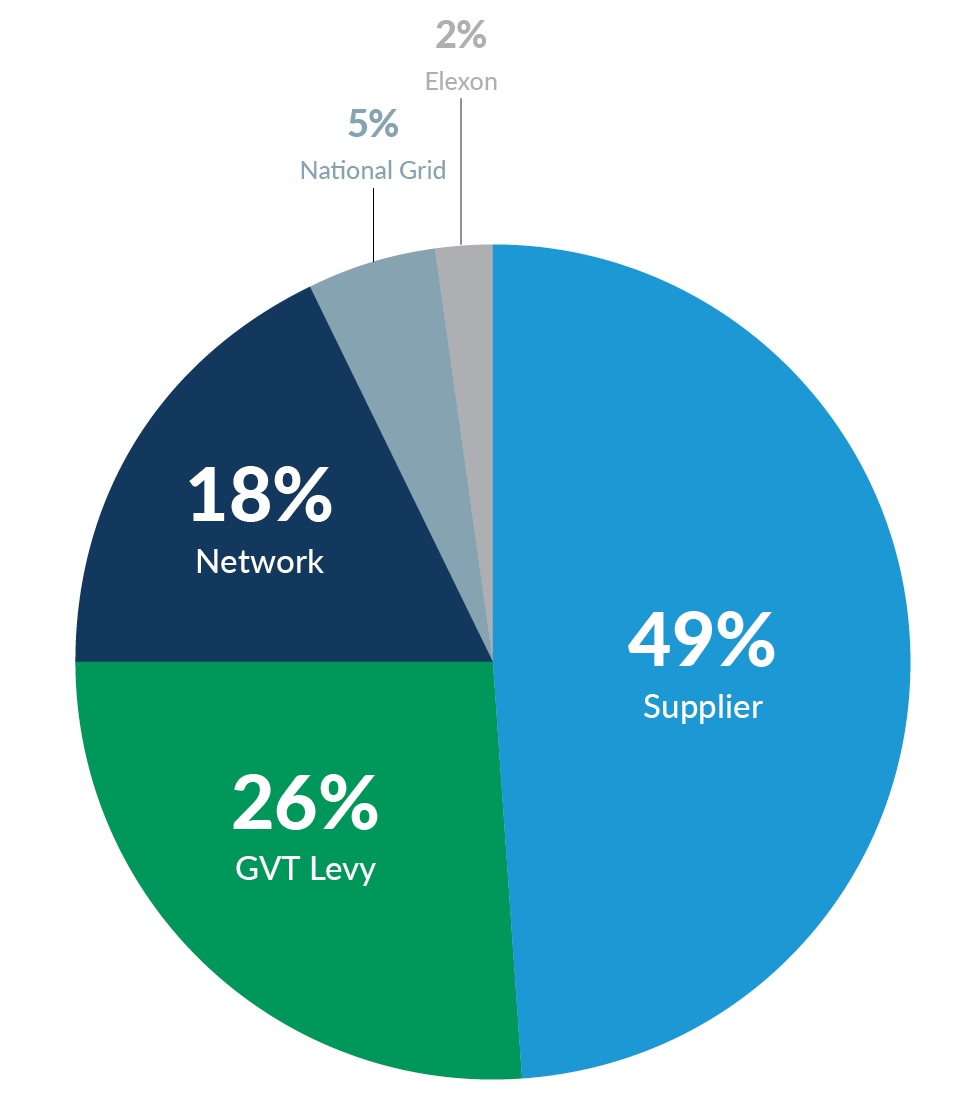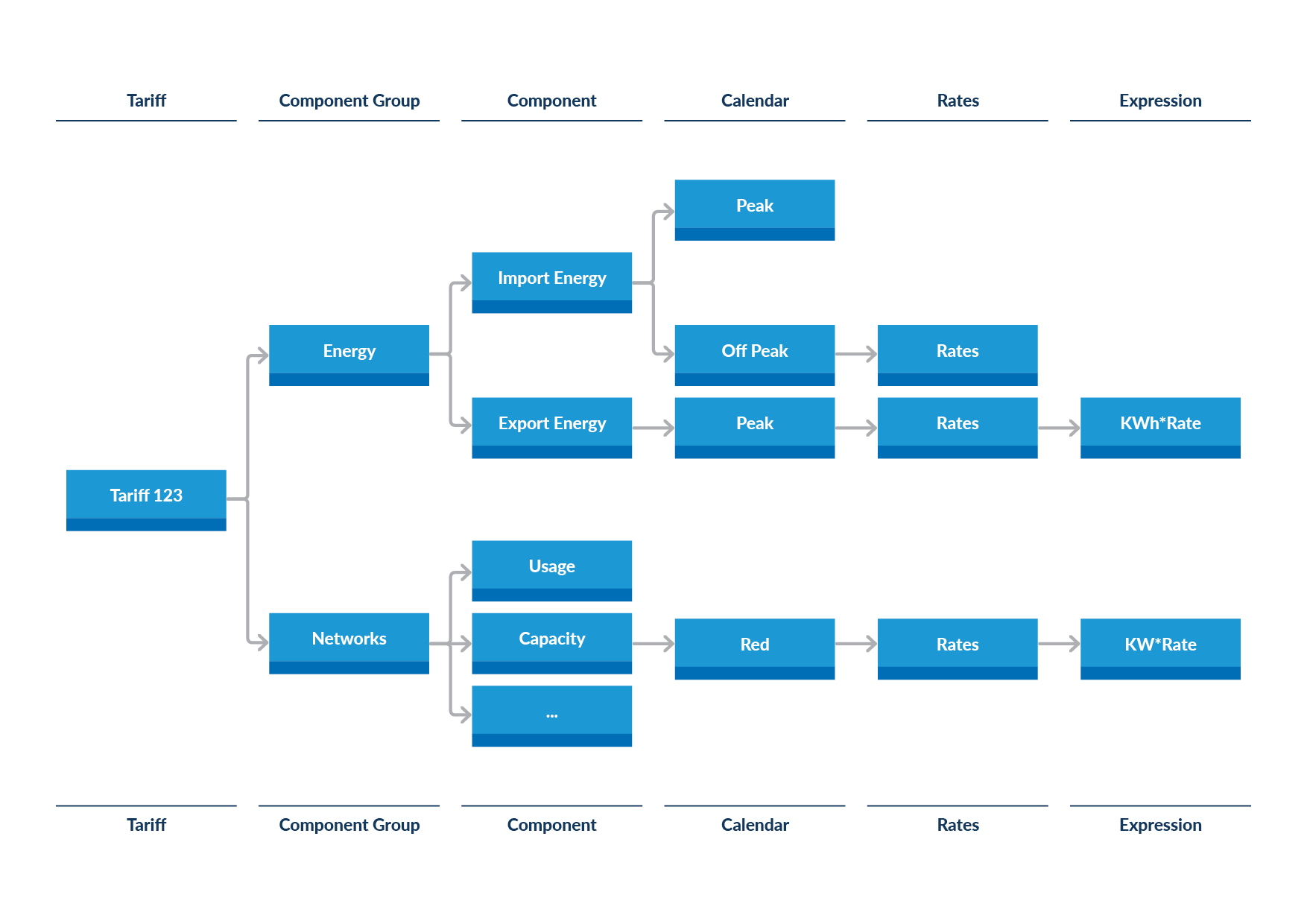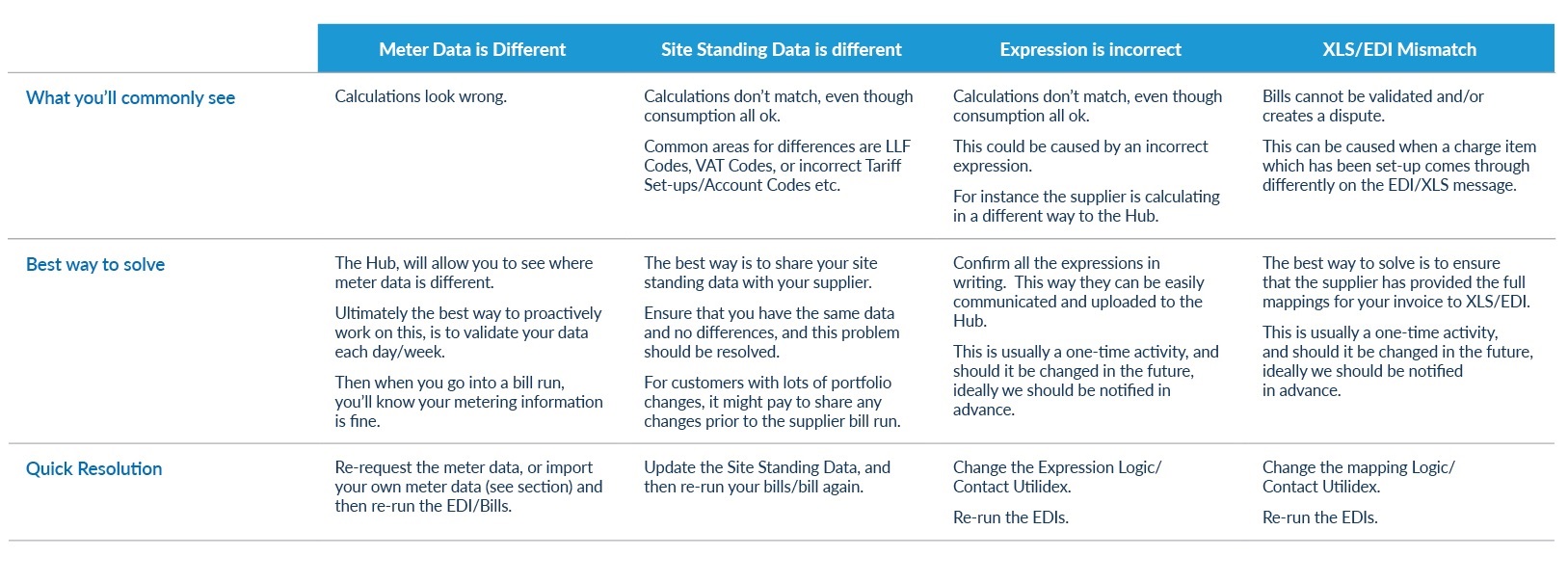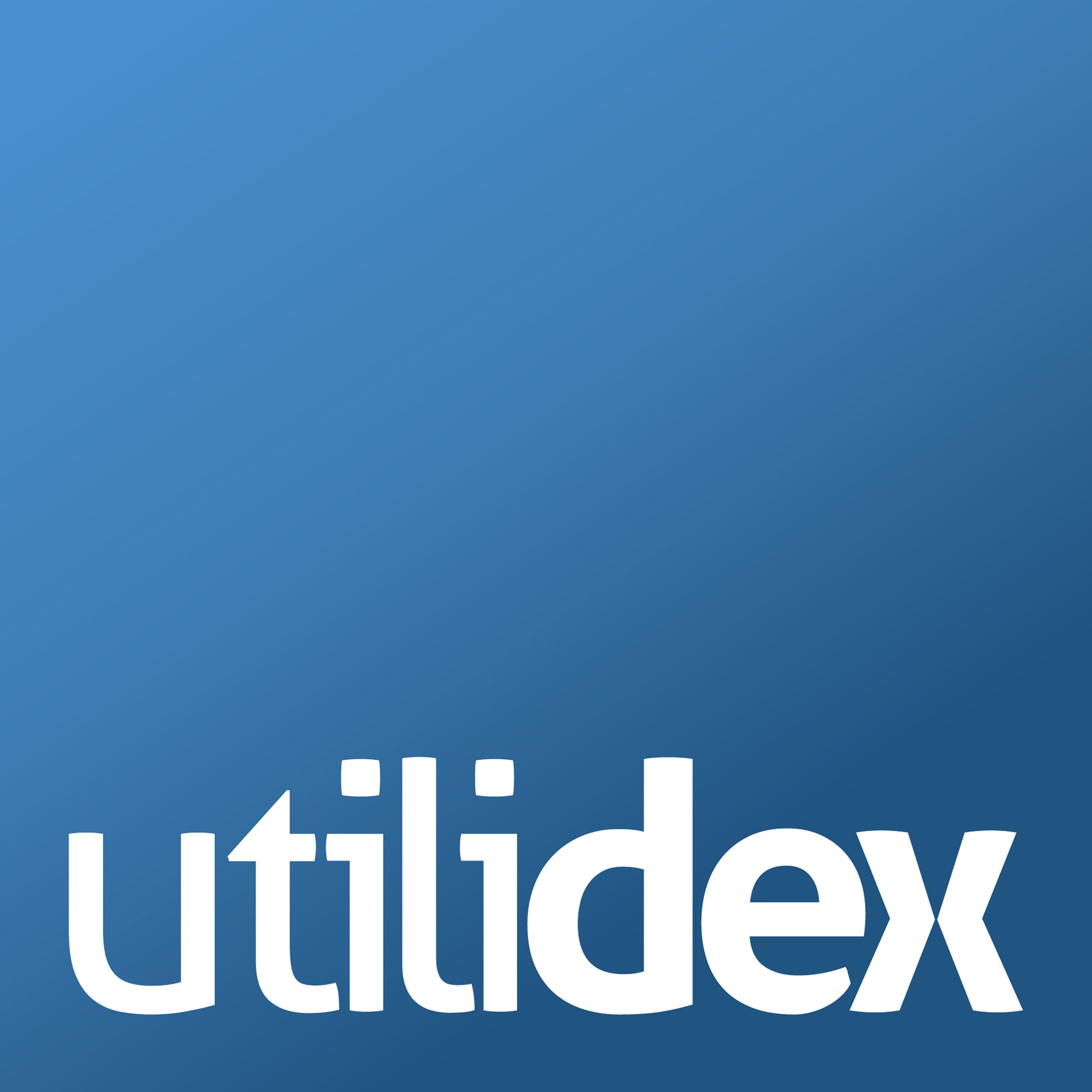So, what makes up your bills?
The energy industry, has done a wonderful job at adding lots of line items to a customer’s bill. This is not because suppliers wish to make the industry complex. It’s just that an energy supplier has to collect monies for lots of different parties within the industry.
If you are a lucky customer, you are probably on a super simple tariff (perhaps a two rate – day/night rate). However if you are like most customers at Utilidex, you are probably on a flex type pass through contract, where you may see 20+ line items on each bill. So here is a bit of a round-up of what to expect on your bill, and how we help you better manage the process of validation.
Your bill is really a mechanism for a supplier to collect all the monies for the various parties that need paying in the energy industry, from the generators, transmission operators, network operators and government levies and taxes (and their own supplier margin!).
The below shows a rough split in % of where the money goes:

You may have heard that “third party charges” are now accounting for over 50% of the bill, well the above shows that. This will vary from customer to customer, but recent trends have shown an increasing proportion of the bill will be third party charges and this will continue to rise.
Complexity of forecasted charges
Most of the calculations are a variation of metering volume, or GSP (Grid Supply Point) volume, or NBP (National Balancing Point) volume multiplied by a rate (we’ll explain more on this later). In some situations however the rate is not known at the time of producing your bill. So suppliers have to forecast a price, and bill based on a forecast, and then re-adjust your bill in a later period. Two such cases of these types of charges are CFD and FiT.
The rates may not be known till the end of the quarter, yet the supplier will bill you for them every month. The below shows what happens in this situation:

Each’s supplier’s method for forecasting can be different, as well as how they manage the adjustment of your bill. For instance, some may adjust in the same month they receive the rate, others may adjust several months later.
When you set-up your Hub, we’ll really need to understand how your forecasted charges are calculated, so that the billing engine can be configured appropriately.
Important: please note that utilidex’s platform, is responsible for calculation of the charges & adjustments. We do not provide advice on whether a forecasted rate is accurate. Customers would need to speak to a consultant on price forecasting, for this particular activity.
Complexity of bundling rates together
Whilst a number of the rates are published – for instance BSUoS, TNUoS etc, Suppliers may also bundle rates together. For instance, they may include the BSUoS rate in the energy rate. When you are setting up the Hub, its important to work with your supplier to determine what rates are calculated in what way, and where rates might be bundled. Again, this can vary from supplier to supplier, so getting it right and setting up your billing platform is key.
Calculating the energy rate
Whilst energy is a diminishing part of the bill, it still does account for some 50% of the bill. So it’s important to validate it. Customers often have a flex contract which is where they purchase certain amounts of energy units in base/peak contracts and then have a residual charge which is the difference between the purchases and the energy consumed.
This calculation too, can have various methods of calculation, where energy suppliers use different indexes, weighted prices etc to calculate the residual rates. The Hub can be configured to support the energy rate calculation, but it’s another rate where clarity is important for the charge expression and how it’s calculated, given that many suppliers have different methodologies.
Important:- Utilidex is not a TPI, we are a software platform. Our goal is to provide an energy platform, that delivers your bill validation, your budgeting, your energy optimisations. It’s one place to manage your energy world. Whilst we can configure the billing/calculation engine, to bill any type of expression/charge you need, we will need to work with you and in turn your supplier, to ensure that everybody understands the calculation logic that needs to be implemented. Getting the expression logic, or rates wrong, can be a major cause for validation issues. So it’s a key part to get right.
The end of the line – Billing
So let’s get started on validation. Bill validation is an “end of the line” process, in that there has been a lot gone on to this point. In fact, if most of your upstream activities have worked well, this should really be a fairly straight forward process.
Before we jump into bill validation, it’s worth noting a couple of things:-
1. Yes there are “billing issues” in our industry. In fact, some people report that this could be as much as 2-3%. So that could equate to a lot of money.
2. In truth though, as people that have worked in the energy industry for some time, we very rarely find real “billing issues”. That is where a software system has done 2 x 2 = 5. In most cases the error has crept in further “upstream” in metering or standing data changes (as the old saying goes “rubbish in, rubbish out”), or alternatively a parties billing system cannot cope with a certain charge element, so they’ve needed manual people on spreadsheets to work it all out. Or maybe an expression logic is different, and not configured the same way as the supplier.
Over this help file topic, we are going to explain how the Hub Platform is configured, how billing & bill validation work within the Hub, and then explain how you can better manage bill validation in your business. Ultimately we know all customers have to manage this process, but we want to make it a painless, easy process for all parties.
From tariffs, to components, to rates
Firstly, its worthwhile explaining some “Hub” language, so you know how the platform works. If you take a look at the below, we’ll then explain some of the concepts:

In the Hub, everything starts with a Tariff. So this could be a “Pass through, complex HH Tariff” or alternatively could be something simple like an “E7 Tariff”. Depending on the size of your portfolio, you could have several tariffs, or maybe only one tariff. And Tariffs may be valid for certain periods of time. So you may have one tariff with supplier X one year, and one tariff with supplier Y for another year.
A tariff is essentially a collection of components. For instance, Energy, or Networks, or Metering. How many components depends on the complexity of the tariff. Using the above example again –Economy 7 may simply have three line items Energy (Day), Energy (Night) and Standing Daily Charge (All Day). Whereas a “Pass through, complex HH Tariff” may have several line items like Energy, DUoS, BSUoS, TNUoS etc…
Each one of these components typically has a calendar (All Day, Peak, Off Peak), a rate and an expression. You can think of an expression like the formulas in excel. The below shows this represented in the Hub Screens:
Important: – whilst some charges are regulated and published, e.g Network Charges (DUoS), other charges may be implemented differently at each supplier. So for instance in energy calculations, the “residual costs” in some cases may be mapped to an index, another case mapped to a weighted price. Some people calculate BSUoS in the current month and adjust, whilst others calculate in arrears. Whilst the Hub supports all different expression types and we’ve come across lots of different permutations, it’s really important to validate what the supplier implementation is.
For a full list of expressions & current libraries that Utilidex supports, please contact your Account Manager.
When “billing errors” aren’t billing errors
Before we dive in, we thought we’d highlight a few items we commonly see, and some suggestions on how best to manage:

Important: for Utilidex best practice guidelines, see the Validation Top Tips at the end of this section. Please note for expression changes/EDI Mapping Changes, Utilidex will need a written confirmation from the customer & supplier, before making any modifications. This is so any changes to charge items, are approved and vetted by both parties, to avoid any future issues.
